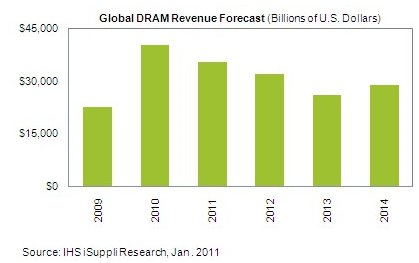
Posted on Wednesday, January 12 2011 @ 15:37 CET by Thomas De Maesschalck
Market research firm iSuppli predicts global DRAM revenue will continue to plunge, this year revenue is expected to decline 11.8 percent year-over-year to $35.5 billion and the first market improvement isn't expected until 2014.
Here's the PR with all the details:
With a huge fall in Average Selling Prices (ASP) predicted for 2011, global DRAM revenue is expected to contract sharply this year despite strong growth opportunities in smart phones and tablets, according to iSuppli, now part of IHS Inc. (NYSE: IHS).
Worldwide DRAM revenue in 2011 is forecast to decline to $35.5 billion, down 11.8 percent from $40.3 billion in 2010. The double-digit drop represents a stark reversal of the 77.5 percent increase in DRAM revenue in 2010 compared to 2009. The next several years after 2011 also will be turbulent for DRAM revenue.
DRAM Market Forecast
Prospects for DRAM—the main memory in game consoles as well as in desktop and laptop PCs—took a sudden turn for the worse in the third quarter of 2010 after ASPs plunged, ending five straight quarters of steady increases. Given the robust channel inventories of that time, stronger bit growth and a retreat in demand primarily in notebook PCs, the market changed direction abruptly and fell more severely than anticipated, ending the DRAM rally.
The reversal of fortune will extend to 2011, iSuppli forecasts. ASPs this year are projected to drop 44.7 percent to $1.44, down from $2.61, in the face of supply continuing to outpace demand. Bit growth, while expected to increase 59.6 percent to 24.6 billion gigabytes (GB), will not make up for the brutal contraction in prices, iSuppli believes.
Not All is Lost: the Flip Side for Consumers
The retreat in the DRAM ASP augurs well, however, for consumers. The price of a 2GB module currently is less than half its level six months ago, a development sure to lead to higher DRAM content in PCs for 2011 and provide consumers with more memory per machine. Furthermore, the new predominant memory configuration in 2011 will be 4GB, to be loaded in half of all desktop PCs, with 2GB systems declining to just 6 percent of the total market by the end of the year.
Consumers also can expect the DRAM market to increasingly transition to newer Double Data Rate 3 (DDR3) modules, which boast faster transfer speeds and consume less power than older DDR2 device types. While DDR2 will continue to be found in many consumer electronics devices such as TVs, nearly all PCs shipped in 2011 will ship with DDR3.
DRAM to Find New Lease on Life with Smart Phones and Tablets
Mobile handsets and tablets promise to be two segments of increasing importance for DRAM companies. While using less memory per device, smart phones and tablets in 2011 will combine to outship PCs by more than 50 million units, making them categories well worth watching, iSuppli believes.
Memory content for smart phones in 2011 will increase at a substantial rate of 62 percent, nearly doubling the 33 percent growth projected in PCs. For their part, tablet shipments will grow rapidly this year to 57 million units, compared to 16 million in 2010—and then become a significant DRAM category rivaling smart phones in 2012 and 2013.
The growth in smart phones and tablets will drive strong demand for mobile DRAM in the years to come. By 2014, mobile DRAM will account for 16.5 percent of all DRAM bits that are shipped—a dramatic increase from just 6.2 percent in 2009.

